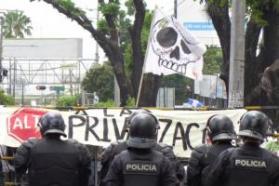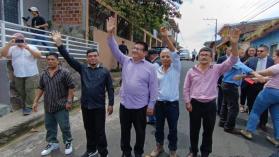Monitoring report: DR-CAFTA in Year One
Monitoringreport: DR-CAFTA in Year One
CAFTA IN YEAR ONE
A report by the StopCAFTA Coalition download the report here
Over the past four months members of the CAFTA MonitoringWorking Group have coordinated the drafting of this report with friends andallies in Central America. While it is far too early to detail long-termtrends in labor, textiles, agricultural practice and policy, investmentpatterns, services, and environmental consequences of CAFTA, in this report wehave looked primarily at the process of implementing CAFTA since January 1,2006 and some early trends and concerns that have emerged, many of which wewill continue to monitor.
Background
The US- Central America Free Trade Agreement (CAFTA) wasinitiated by the Bush administration in January of 2002 as an effort torevitalize faltering talks for a Free Trade Area of the Americas. After a year of preliminary discussions,"negotiations" began in February of 2003 and were completed in December of thatyear between the United States,El Salvador, Guatemala, Nicaragua,and Honduras. Costa Rica joined the accord inJanuary of 2004, and all six countries formerly signed in May of 2004. In August of 2004 the Dominican Republicwas docked to the core agreement creating the U.S.-Dominican Republic-CentralAmerica Free Trade Agreement (DR-CAFTA).
CAFTA was adopted first by ElSalvador in December of 2004; Hondurasand Guatemala in March of2005; the United States inJuly of 2005; and Nicaraguaand the Dominican Republicin September of 2005.
CAFTA was initially intended for implementation on January1, 2006. Shortly before, in mid-December2005, the United States Trade Representative (USTR) announced that in itsestimation, countries in Central America hadfailed to fully enact laws necessary to bring their legal systems intocompliance with changes mandated by the CAFTA. At this point the USTR set in motion a process of rollingimplementation, whereby, the USTR would certify countries as ready to implementCAFTA on a case-by-case basis. As aresult of this policy CAFTA was implemented first by the United States and ElSalvador on March 1, 2006; Nicaraguaand Honduras on April 1,2006; and Guatemalaon June 1, 2006.
The DominicanRepublic has yet to fully comply withdemands by the USTR and has not yet implemented the agreement. Costa Rica remains the only countryto have not ratified the agreement.
Findings of "CAFTA inYear One" Report
The process of rolling implementation has had negativeconsequences for the region and for the United States by creating confusiongoverning rules of origin for textiles. The result has been lost jobs in the UnitedStates and parts of Central America. Far from creating the promised regionaltextile complex to offset competition from China,the ham-handed approach to implementing CAFTA has contributed to a trend,already in place, of Central America losing market share to competitors from Asia.
The confusion surrounding implementation has been by andlarge the creation of the United States Trade Representative and Congressionalleadership. The USTR has insisted on newconcessions from Central American counterparts that go beyond items negotiatedduring CAFTA discussions. Theseconcessions include:
- Demandsto re-interpret intellectual property rules to grant extended periods ofprotection for U.S.based pharmaceutical companies.
- Requirementsthat governments in Central America adopt U.S. Department of Agriculturemeat inspections protocols, thereby foregoing their rights to inspect meatpackers prior to issuing export licenses in the United States andre-inspecting meat at the border.
- Forcingcountries to accept USTR interpretations of a host of disagreements concerningtariff-rate quotas and distribution of import licenses.
- Demandsthat all of these disputes be settled by changes in the civil codes of allof the countries in order to cut off the potential for legal challengeslater.
The USTR has been unwilling to compromise meaningfully withany of its partners, even when the new demands were part of negotiationsbetween the Bush administration and Congressional Republicans that helped passCAFTA by a slim 2-vote margin.
The delays in implementation have been especially long in Guatemala and the DominicanRepublic, and as mentioned in the reports on Guatemala,outstanding issues concerning pocket linings and taxes on beer still have notbeen settled even after the implementing deadline has passed.
As chapter 9 on agriculture in ElSalvador notes, there is already evidence of stress tothe rural economy of Central America that isbeing exacerbated by CAFTA. Imports ofitems such as fresh beef and a variety of dairy products to CentralAmerica have increased dramatically. Guatemalahas already submitted a case before the World Trade Organization for dumping ofchicken quarters by U.S.poultry exporters. In El Salvador, inflation is increasing, includingfor food items, indicating that despite promises to the contrary increased foodexports from the UnitedStates are not leading to lower food prices.
As chapters 1 on El Salvadorand chapter 2 on Nicaraguanote, another impact of CAFTA implementation we are seeing is the cost to thegovernment of initiating programs to prepare the rural economy for thedisruptions. The Nicaraguachapter documents a program that shows how support funds are being absorbed bylarger producers, not small farmers who desperately need them. Further disruptions to the rural economy willlead to expanded migration, both within Central Americaand to countries outside the region.
There has been no improvement of the human rights situationin Central America under CAFTA. Indeed, thereis evidence that CAFTA and other neo-liberal reforms are increasing socialconflicts and in El Salvador,Guatemala and Honduras thestate is responding with increased violence, or failing to protect socialactivists non-violently demanding their rights. This is another trend that we will continue to monitor closely.
Finally, there was a great deal of concern about thesituation of worker rights in Central Americaexpressed by members of Congress during the CAFTA fight. While too early to draw specific conslusions,we simply note that few collective bargaining agreements exist with non-companyunions in the free trade zones of Central America,and the age old practice of firing union leadership in an effort to squashorganizing efforts continues unabated. There will be longer reports on worker rights enforcement in the monthsto come.
Also, we note that coalitions of legal scholars, lawyers,and civil society organizations in the countries of CentralAmerica have presented legal challenges to domestic and regionalcourts calling into question the constitutionality of the implementinglaws. This is another area we hope toreport on as the cases progress.
The MonitoringWorking Group
The task of monitoring CAFTA impacts is an ongoing one. The goal of the Working Group is to continueto coordinate monitoring efforts and to do periodic reporting on the impact ofpolicies enacted to implement CAFTA. This first preliminary report onimplementation is issued on September 12, 2006 in the hopes that concernsraised in this report will resonate with members of Congress as they look toagreements with Peru and Colombia.

 "I am a CISPES supporter because continuing to fight for social justice and a more people-centered country means continuing the dream and sacrifice of thousands of my fellow Salvadorans who died for that vision.” - Padre Carlos, New York City
"I am a CISPES supporter because continuing to fight for social justice and a more people-centered country means continuing the dream and sacrifice of thousands of my fellow Salvadorans who died for that vision.” - Padre Carlos, New York City

